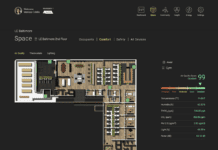This Web Exclusive has been contributed by Ron Rounsaville, plant manager at Holman Boiler Works in Dallas, TX.
I have a photo hanging in my office of a biscuit and sausage sandwich sitting in the middle of a pristine floor at the factory in Dallas where I’m the facility manager. The sandwich belonged to my boss, Holman CEO, John Marrinucci.
After I took the picture, he ate the sandwich.
That gleaming factory floor is a visible manifestation of our drive to be the leader in the application of 21st century engineering and manufacturing techniques in an industry steeped in tradition.
For us, that drive starts with a zero-injury culture. We’re doing this to protect the employees. We want employees to go home at night in as good a condition as when they arrived to the plant. We’re also improving quality, improving morale, controlling insurance costs, and increasing productivity. But there’s another reason that’s becoming increasingly important to the future of our company. And that’s sales.

In the highly competitive business of boiler repair and refurbishment, a bad safety record can kill a sale. We do much of our work at the customers’ facilities. They don’t want us around if we don’t have a good safety record.
Together with John Ianonne, director of engineering at Holman who has company-wide responsibility for safety, we are relying on the principles of Lean Six Sigma to make sure customers want us around. It’s an approach that our CEO, a Six Sigma/Lean Black Belt, has used before. Six Sigma, 5S, and Lean principles are being applied in a number of industries, and Holman’s CEO has implemented them in previous careers. Now we’re using the principles to upend the way business is done in the boiler industry, which can have a “no school like the old school” mentality.
Our zero-injury effort is not compliance based like many in the boiler industry. We are firm believers in using Lean Six Sigma principles to ensure a continuous approach and company-wide involvement in making changes to our operations. That’s why we implemented daily “toolbox” meeting where supervisors review safety procedures with their employees and weekly all hands meetings where I review issues and near misses.
It’s also why I convened a “kaizen blitz” to focus on the Dallas factory layout, which was contributing to safety problems. Kaizen is a Japanese term that’s been defined as “to take apart and put back together in a better way.” With the blitz approach, I signaled to everyone that we intended to move fast. I pulled together a team of people to look at shop layout and work flow and we mapped out a total redo of the factory floor that’s coming close to completion.
Some think that Lean Six Sigma is more suited to factories producing a high volume/low mix product line, but it just takes more thought to apply the principles to a custom job production environment we have here at Holman. As the plant floor layout is being changed to streamline production, we are also implementing changes to the warehouse and the receiving department to better handle the just-in-time production that the new layout will facilitate
I’m a firm believer in the Lean Six Sigma practice of asking “why” five times. It’s the only way to get to the root of a problem and solve it. We treat mistakes like nuggets that give us the opportunity to learn.
John Ianonne is taking the Lean Six Sigma approach to the company’s other boiler shops and sales offices throughout Texas and the Midwest. He is also focusing heavily on infusing the zero-injury culture among the company employees who work at customer sites repairing and replacing boilers. These people are really working in the most dangerous environments since these are, by definition, unfamiliar environments.
To make sure the field workers are aware of the possible hazards at other sites, each day begins with a walk-through of the site to review the possible workplace hazards and note any changes in the environment the workers should be aware of. Our focus in the field is to teach people hazard awareness before they start work so that they can map out a safe way to get the job done.
To help drive on the focus on safety, John Ianonne and John Marrinucci recently completed a round of formal safety training at every company facility to reorient everyone to our new safety policies. Prior to the training we circulated a survey asking employees to grade the company how important they thought their safety was to the company.
Our grade wasn’t bad, but the results showed several areas for improvement. We plan to repeat of the survey in few months. We’ve also set up a special e-mail address that employees can use to report any safety concerns they may have or problems they encounter.
Taking a lean approach to safety ensures that the program is proactive. Rather than just report negative metrics like injuries or lost-time accidents, we treat every incident, near miss or accident as an opportunity for safety improvements. And the work is paying off. After a recent plant tour, I received an email from the customer complimenting me on the cleanliness or the plant.
I hung a copy of the email next to the biscuit and sausage photo.
















![[VIDEO] Collect Asset Data at the Speed of Walking a Building](https://facilityexecutive.com/wp-content/uploads/2024/02/maxresdefault-324x160.jpg)